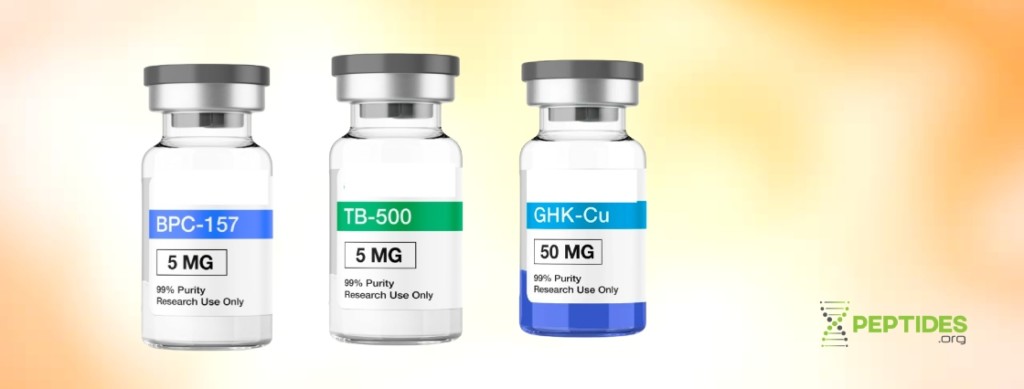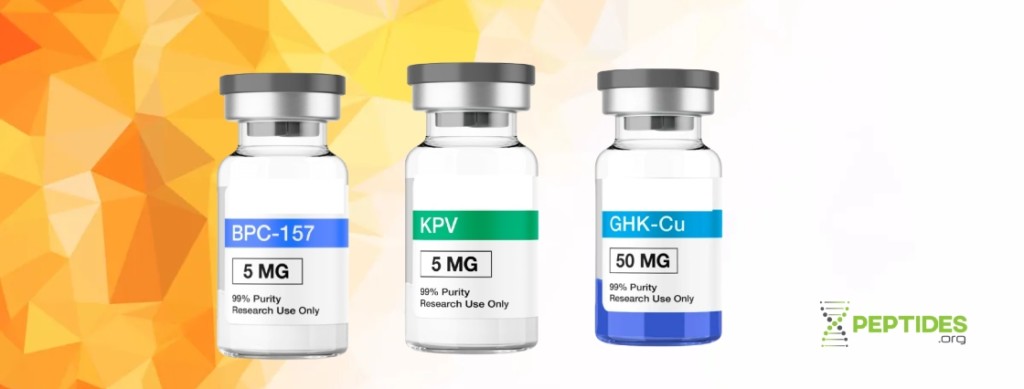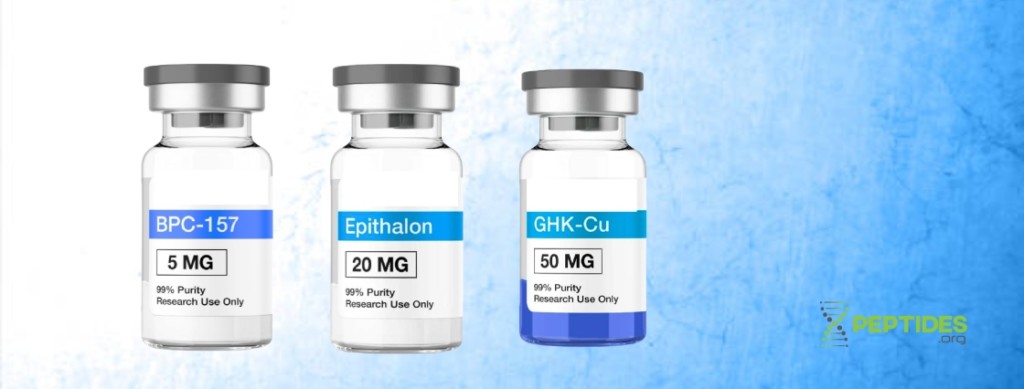Peptides for healing and recovery have gained much attention due to their massive potential and unique mechanisms.
Notable compounds like BPC-157, TB-500, and GHK-Cu have shown benefits in various areas of research, including:
- Wound and gut healing
- Reducing inflammation
- Muscle and tendon injury recovery
This review will break down the latest preclinical and clinical data on peptides for healing, and will cover their mechanisms of action, effectiveness, and safety.
Be sure to read through the end to discover our favorite source of research peptides for healing and repair.
Buy research peptides from our top-rated vendor...

Disclaimer: Peptides.org contains information about products that are intended for laboratory and research use only, unless otherwise explicitly stated. This information, including any referenced scientific or clinical research, is made available for educational purposes only. Likewise, any published information relative to the dosing and administration of reference materials is made available strictly for reference and shall not be construed to encourage the self-administration or any human use of said reference materials. Peptides.org makes every effort to ensure that any information it shares complies with national and international standards for clinical trial information and is committed to the timely disclosure of the design and results of all interventional clinical studies for innovative treatments publicly available or that may be made available. However, research is not considered conclusive. Peptides.org makes no claims that any products referenced can cure, treat or prevent any conditions, including any conditions referenced on its website or in print materials.
Top 3 Peptides For Healing, Repair, and Recovery
Before we go deep into the science of peptides for healing, injury repair, and recovery, here are three of the most noted peptides in this field.
1. BPC-157
BPC-157 is a peptide with a wide potential for healing benefits, having been deployed in the recovery of tendons, ligaments, skin wounds, injured muscles, intestines, and more. It is thought to work by upregulating various growth factors, stimulating neovascularization, and increasing collagen synthesis. While available laboratory animal data on BPC-157 do not report any side effects, the peptide has unfortunately undergone little clinical testing [1, 2, 3, 4, 5].
2. TB-500
TB-500 is a synthetic version of the naturally occurring thymosin beta 4 (TB4) protein, which is found in almost all human cells. The peptide appears to upregulate cell motility and migration by interacting with the cellular cytoskeleton, specifically inhibiting the polymerization of globular actin (G-actin) into filamentous actin (F-actin). As a result, TB-500 may facilitate the migration of progenitor cells to injury sites and speed up recovery in various tissues, including cardiac muscle, eye cornea, skin, and connective tissue [6, 7, 8, 9, 10, 11, 12].
3. GHK-Cu
GHK-Cu is a tripeptide (glycyl-L-histidyl-L-lysine) copper complex occurring in human bodily fluids and believed to act as a repair signal. Its levels decline with age. As a research peptide, GHK-Cu may be applied topically against skin wrinkles, but its healing and injury recovery properties are best expressed when administered via injection. It has been reported to exert protective effects on the skin including by stimulating collagen production [13, 14].

What are Peptides?
Peptides are organic molecules that are produced endogenously in all organisms. They can also be produced via various laboratory methods, such as solid-phase peptide synthesis (SPPS).
Peptides are made of amino acids linked together via amide linkages to produce an amino acid sequence—the primary structure of a peptide. Essentially small proteins consisting of up to approximately 50 amino acids, peptides usually encompass a single polypeptide chain, whereas larger proteins quite often consist of multiple chains with amino acids numbering in the hundreds or even thousands [15].
Peptides are usually linear, although some also possess cyclic or branched structures. Naturally occurring peptides play pivotal roles in a wide range of physiological processes, including but not limited to:
- Cellular signaling
- Cellular motility
- Hormonal regulation
- Immune regulation
At the same time, peptides are selective in their affinity, which also helps minimize unwanted interactions. These properties have drawn the attention of clinicians and scientists worldwide, leading to the development of therapeutic peptides [16].
Therapeutic peptides are often based on their endogenous counterparts but may possess various modifications that improve their stability, selectivity, pharmacokinetics, safety, and effectiveness.
The United States Food and Drug Administration (FDA) has already approved about 60 peptide-based medications for various indications, while hundreds of other peptides are under active research for their potential implications [17].
How Do Peptides Work For Injury Recovery and Repair?
Peptides for healing can work in multiple ways to improve cell proliferation, blood vessel formation, and tissue recovery. Here are some of the mechanisms behind these processes:
- Upregulating growth factors: In the context of injury recovery, peptides can stimulate the body to produce new cells and blood vessels by upregulating growth factors such as vascular endothelial growth factor (VEGF) and early growth response gene-1 (EGR-1). For example, the BPC-157 peptide has been shown to upregulate the healing in epithelial tissues, tendons, and muscles by upregulating EGR-1 and collagen formation [18, 19].
- Mimicking cellular repair signals: The peptide GHK-Cu has an identical sequence to the one formed after the enzymatic breakdown of skin collagen (the alpha 2(I) chain of type I collagen) in the event of injury. Thus, applying GHK-Cu may act as a repair signal that initiates skin recovery processes [13, 14].
- Upregulating cellular motility: Peptides like TB4 (TB-500) alter the cellular cytoskeleton, affecting cells' ability to move and change shape. This process may help progenitor cells of different tissues migrate to a site of injury, thereby facilitating healing [20, 21].
- Reducing inflammation: While inflammation is an essential part of the recovery of any tissue, excessive inflammation can lead to the production of active radicals and cause further damage to injured tissue. Therefore, inhibiting certain inflammatory mediators may prove beneficial. KPV tripeptide has been shown to suppress pro-inflammatory cytokine secretion and reduce inflammation [22]. TB4 has been associated with decreased active radical formation, antioxidative effects, and reduced tissue fibrosis (scar formation) [23].
These beneficial processes result in reduced tissue damage, upregulated collagen-producing fibroblasts, vessel growth, and cell proliferation. Increased collagen specifically provides structure to the skin, tendons, and ligaments and ensures elasticity in bone tissue.
The above mechanisms are especially important for the recovery of connective tissues such as ligaments, tendons, and joints.
Does Peptide Therapy Work for Healing Injuries?
Current research supports the effectiveness of peptides for healing tissues including skin, ligaments, tendons, joints, muscles, and the gastrointestinal tract.
Here are some of the most notable scientific publications on the subject:
- Muscle tissue recovery in clinical settings: TB-500 (TB4) has shown significant potential for speeding up the healing of cardiac muscle in a study in patients following myocardial infarction. The patients received a transplant of endothelial progenitor cells, either pre-treated with TB4 or not. Those with pre-treated transplants experienced a better recovery within six months, as assessed by improvements in cardiac function and a six-minute walking distance test [12].
- Wound healing in preclinical and clinical settings: In a rabbit model of wound healing, GHK alone or in combination with high-dose helium-neon laser improved wound contraction, granular tissue formation, and blood vessel growth [14]. In a clinical trial, TB4 at a dose of 0.03% applied topically to venous ulcers led to complete wound healing in 33.3% of patients, compared to 23.5% for placebo. The volunteers who experienced complete healing achieved it 45% faster with TB4 [11].
- Healing of tendons and ligaments in laboratory models: BPC-157 has been reported to reduce inflammation, increase collagen production, and induce early functional recovery in Achilles tendon-to-bone healing in murine models [2, 3].

Best Peptides For Healing | Top 5
Below, we break down five of the most researched peptides for healing, injury repair, and recovery, including their respective mechanisms and benefits.
BPC-157
BPC-157 (Body Protection Compound-157) is a synthetic pentadecapeptide discovered by Sikiric et al. (1993) and described as a peptide isolated from gastric juices [5, 18, 24, 25].
The peptide may activate growth factors and cells involved in connective tissue repair, such as fibroblasts, while upregulating the production of vasodilators like nitric oxide (NO). This may help heal skin, tendons, and muscles [18, 19, 26, 27].
Unfortunately, the peptide has yet to undergo thorough clinical testing, and the only clinical trial performed on patients with inflammatory bowel disease (IBD) has not been published [28].
Nevertheless, preclinical studies report the following potential benefits for healing:
- Improved healing in laboratory animal models of crushed muscles that were treated with BPC-157 [1].
- Improved recovery in Achilles tendon-to-bone healing in a rat model [2, 3].
- Improved intestinal healing, villus height, crypt depth, and muscle thickness in the intestines of rats with surgically induced short bowel syndrome who received oral BPC-157 [4].
- Improved healing in rats with alkali burns who received topical BPC-157. The peptide accelerated wound closure and improved tissue healing compared to the control group [5].
Buy BPC-157 from our top-rated vendor...

TB-500
TB-500 is a synthetic form of TB4, which itself was first isolated in 1981 by Low and Goldstein from bovine thymus gland extract [29].
TB4 is a 43 amino acid peptide found in most human cells, and is under active research for its potential effects on cell migration, namely the migration of progenitor cells. It may also play a role in the formation of new blood vessels, maturation of stem cells, survival of various cell types, and reducing inflammation [8, 9].
The synthetic version, TB-500, was initially manufactured in the early 2010s for veterinary use [30, 31]. A naturally-occurring fragment of thymosin beta 4, called N-acetyl seryl-aspartyl-lysyl-proline (Ac-SDKP), is an orally active peptide that may also possess effects on cell migration along with anti-inflammatory properties [32, 33].
The available data indicate the following potential effects of synthetic TB4 (TB-500):
- TB-500 may help the healing of the eye cornea, as noted in a 28-day phase-2 study in nine patients with severe dry eye. At day 56, the six patients on TB-500 demonstrated a 35.1% higher reduction in ocular discomfort and a 59.1% higher reduction in total corneal fluorescein staining (indicator for corneal damage) compared to the control group [10].
- TB-500 has been shown to accelerate wound healing in patients with venous ulcers by 45% [11].
- TB-500 has likewise been shown to improve heart muscle function and recovery following myocardial infarction in study volunteers treated with endothelial progenitor cells [12].
Buy TB-500 from our top-rated vendor...

GHK-Cu
GHK-Cu is composed of a tripeptide (glycyl-L-histidyl-L-lysine) present in human fluids. This compound is recognized for its repair signaling properties, with its natural presence diminishing with age [13].
Originally identified by Dr. Loren Pickart in 1973, GHK-Cu's potential came to light when aged liver cells exhibited regeneration upon exposure to blood from younger subjects, attributing the effect to this peptide [34].
A key mechanism underlying its action may be the promotion of collagen synthesis, which is integral to its wound healing capacities [13].
Specifically, GHK-Cu has been associated with:
- Protective effects on the skin, stimulation of collagen production, and enhancement of wound healing [14].
- Potential in promoting liver cell regeneration in clinical study participants and expediting wound recovery post ACL reconstruction surgery in mice [34, 35, 36].
Buy GHK-Cu from our top-rated vendor...

KPV
KPV, composed of lysine-proline-valine, is identified as the C-terminal end of the larger alpha-melanocyte-stimulating hormone (α-MSH), which is endogenously produced in the body.
Found in the pituitary gland in vertebrates including humans, α-MSH is a melanocortin receptor agonist that contributes to several physiological processes, including melanogenesis, appetite modulation, and sexual desire. Moreover, it exhibits anti-inflammatory effects, particularly facilitated by its C-terminal fragment, KPV [37].
These anti-inflammatory actions encompass the regulation of various inflammatory responses such as NF-κB activation, T-cell proliferation, adhesion molecule expression, inflammatory cytokine and chemokine receptor expression, and inflammatory cell migration [38].
Relevant research indicates that:
- Several studies have suggested that α-MSH has anti-inflammatory and wound healing effects, which may translate to KPV, as well [39].
- KPV has been shown to facilitate corneal epithelial wound healing in rabbits. When test animals were administered KPV in varied concentrations for four days, all KPV-treated corneas were entirely re-epithelialized within sixty hours, contrary to placebo [40].
Buy KPV from our top-rated vendor...

Epithalon
Epithalon is a tetrapeptide (Ala-Glu-Asp-Gly) that is derived from polypeptides extracted from the pineal gland. It was developed in Russia and investigated for its potential regenerative effects in various tissues.
It may work by interacting with the DNA to slow down aging, more specifically by enhancing telomerase activity in cells and elongating their telomeres [41].
Studies suggest that epithalon may enhance sleep, reduce inflammation, repair DNA, and improve healing [42, 43, 44, 45].
Research reports the following benefits of epithalon:
- Epithalon may improve the healing of connective tissues by preventing fibroblast apoptosis and collagen degradation [46].
- Epithalon may deploy antioxidant defense systems and reduce oxidative stress in various laboratory animal models [47, 48, 49].
Epithalon may decrease levels of DNA damage when administered to senescence-accelerated mice [50].
Buy Epithalon from our top-rated vendor...

Peptides Side Effects and Safety
The research peptides on this list lack comprehensive safety data and regulatory approval for human use of any kind.
However, available clinical data on TB-500 (TB4), GHK-Cu, and epithalon suggest that said peptides are well-tolerated without any notable side effects [14, 45].
Only one TB-500 human study has reported mild side effects following 14 days of therapy in 10 subjects at singles doses of 42-1260mg. There were a few cases of headache, dizziness, and fever [51].
The side effects of BPC-157 remain largely unknown due to the lack of published clinical data. Laboratory experiments suggest that the peptide is well-tolerated with virtually no toxicity, even at high doses [52].
Since the aforementioned peptides are applied via subcutaneous injection, researchers should be aware of the potential for local side effects, such as pain, bleeding, induration, and redness.
As for potential complications over the long-term, clinical data are needed before any conclusions can be drawn. Meanwhile, it is important to note that there is a concern that prolonged use of angiogenesis-promoting agents, such as BPC-157, TB-500, and GHK-Cu, might have the potential for complications, which are discussed in peptide safety articles also published on Peptides.org.
Peptides For Joints, Ligaments, Tendons, and More
We’ll now review the best-studied and potentially most beneficial peptides for the recovery and healing of different tissues based on the available scientific data.
Best Peptides for Healing Joints?
Reducing inflammation is a major part of recovery following joint injury, and peptides such as TB-500 have consistently shown significant anti-inflammatory properties [8, 9]. Some researchers have also suggested that this peptide may be beneficial in patients with rheumatoid arthritis [53].
Best Peptides for Gut Healing?
We highly recommend the synergistic combination of BPC-157 & KPV in capsule form, as both peptides are researched for their gut healing and wound healing properties. Oral BPC-157 significantly improves gut healing following intestinal surgery in laboratory animals [4]. These benefits may be enhanced by the anti-inflammatory effects of KPV [38].
Best Peptides for Healing Ligaments?
BPC-157 may be the best peptide for healing ligaments. Scientific studies underscore the efficacy of BPC-157 in enhancing ligament healing, particularly in Achilles tendon-to-bone recovery in rats, by reducing inflammation, promoting angiogenesis, and optimizing collagen fiber organization [2, 3].
Best Peptides for Bone Healing?
BPC-157 is thought to improve bone healing, although the only available evidence comes from laboratory animal trials. Investigations utilizing BPC-157 in rabbits with insufficiently healed bone defects revealed substantial improvements in healing as evidenced by radiographic, micro photo densitometry, and histomorphometric assessments [54].

Peptides For Recovery and Repair | Verdict
The most actively researched peptides for healing and regeneration are BPC-157, TB-500, and GHK-Cu. They exhibit promising effects through multiple mechanisms, including by enhancing angiogenesis, reducing inflammation, and promoting cellular migration.
Yet, clinical data are scarce and many of these peptides remain under active scientific investigation. Qualified researchers can procure these compounds for use in academic and investigative contexts.
Researchers in pursuit of top-tier healing peptides for investigation are encouraged to visit our top recommended supplier today!
